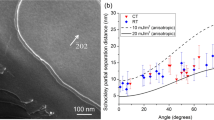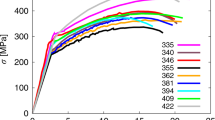Abstract
Despite significant advances in computational materials science, a quantitative, parameter-free prediction of the mechanical properties of alloys has been difficult to achieve from first principles. Here, we present a new analytic theory that, with input from first-principles calculations, is able to predict the strengthening of aluminium by substitutional solute atoms. Solute–dislocation interaction energies in and around the dislocation core are first calculated using density functional theory and a flexible-boundary-condition method. An analytic model for the strength, or stress to move a dislocation, owing to the random field of solutes, is then presented. The theory, which has no adjustable parameters and is extendable to other metallic alloys, predicts both the energy barriers to dislocation motion and the zero-temperature flow stress, allowing for predictions of finite-temperature flow stresses. Quantitative comparisons with experimental flow stresses at temperature T=78 K are made for Al–X alloys (X=Mg, Si, Cu, Cr) and good agreement is obtained.
This is a preview of subscription content, access via your institution
Access options
Subscribe to this journal
Receive 12 print issues and online access
$259.00 per year
only $21.58 per issue
Buy this article
- Purchase on Springer Link
- Instant access to full article PDF
Prices may be subject to local taxes which are calculated during checkout



Similar content being viewed by others
References
Fleischer, R. L. Substitutional solution hardening of copper. Acta Metall. 14, 1867–1868 (1966).
Mott, N. F. & Nabarro, F. R. N. Dislocation theory and transient creep. Phys. Soc. Bristol Conf. 1–19 (1948).
Kocks, U. F., Argon, A. S. & Ashby, M. F. Thermodynamics and kinetics of slip. Prog. Mater. Sci. 19, 1–281 (1975).
Haasen, P. Physical Metallurgy (Oxford Univ. Press, 1996).
Labusch, R. A statistical theory of solid solution hardening. Phys. Status Solidi 41, 659–669 (1970).
Argon, A. S. Strengthening Mechanisms in Crystal Plasticity (Oxford Univ. Press, 2004).
Kresse, G. & Hafner, J. Ab initio molecular dynamics for liquid metals. Phys. Rev. B 47, 558–561 (1993).
Kresse, G. & Furthmuller, J. Efficient iterative schemes for ab initio total-energy calculations using a plane-wave basis set. Phys. Rev. B 54, 11169–11186 (1996).
Rao, S., Hernandez, C., Simmons, J. P., Parthasarathy, T. A. & Woodward, C. Green’s function boundary conditions in two-dimensional and three-dimensional atomistic simulations of dislocations. Phil. Mag. A 77, 231–256 (1998).
Labusch, R. Statistical theories of solid-solution hardening. Acta Metall. 20, 917–927 (1972).
Zaiser, M. Dislocation motion in a random solid solution. Phil. Mag. A 82, 2869–2883 (2002).
Olmsted, D. L., Hector, L. G. Jr & Curtin, W. A. Molecular dynamics study of solute strengthening in Al/Mg alloys. J. Mech. Phys. Solids 54, 1763–1788 (2006).
Basinski, Z. S., Foxall, R. A. & Pascual, R. Stress equivalence of solution hardening. Scr. Metall. 6, 807–814 (1972).
Diak, B. J. & Saimoto, S. The determination of solute clusters in dilute aluminium alloys using strain rate sensitivity. Mater. Sci. Eng. A 234, 1019–1022 (1997).
Diak, B. J., Upadhyaya, K. R. & Saimoto, S. Characterization of thermodynamic response by materials testing. Prog. Mater. Sci. 43, 223–363 (1998).
Woodward, C., Trinkle, D. R., Hector, L. G. Jr & Olmsted, D. L. Prediction of dislocation cores in aluminum from density functional theory. Phys. Rev. Lett. 100, 045507 (2008).
Vanderbilt, D. Soft self-consistent pseudopotentials in a generalized eigenvalue formalism. Phys. Rev. B 41, 7892–7895 (1990).
Perdew, J. P. & Wang, Y. Accurate and simple analytic representation of the electron-gas correlation-energy. Phys. Rev. B 45, 13244–13249 (1992).
Perdew, J. P. & Wang, Y. Pair-distribution fuction and its coupling-constant average for the spin-polarized electron-gas. Phys. Rev. B 46, 12947–12954 (1992).
Monkhorst, H. J. & Pack, J. D. Special points for Brillouin-zone integrations. Phys. Rev. B 13, 5188–5192 (1976).
Methfessel, M. & Paxton, A. T. High-precision sampling for Brillouin-zone integration in metals. Phys. Rev. B 40, 3616–3621 (1989).
Vannarat, S., Sluiter, M. H. F. & Kawazoe, Y. First-principles study of solute–dislocation interaction in aluminum-rich alloys. Phys. Rev. B 64, 224203 (2001).
Acknowledgements
Support for this work was provided through the GM/Brown Collaborative Research Lab on Computational Materials Research, with further support through the NSF Materials Research Science and Engineering Center at Brown on Micro- and Nano-Mechanics of Materials (grant DMR-0520651).
Author information
Authors and Affiliations
Contributions
W.A.C., L.G.H.Jr and C.F.W. designed the research plan; G.P.M.L., L.G.H.Jr and C.F.W. carried out various aspects of the quantum energy calculations; G.P.M.L. and W.A.C. developed the analytic strengthening model; G.P.M.L., W.A.C. and L.G.H.Jr wrote the paper.
Corresponding author
Ethics declarations
Competing interests
The authors declare no competing financial interests.
Rights and permissions
About this article
Cite this article
Leyson, G., Curtin, W., Hector, L. et al. Quantitative prediction of solute strengthening in aluminium alloys. Nature Mater 9, 750–755 (2010). https://doi.org/10.1038/nmat2813
Received:
Accepted:
Published:
Issue Date:
DOI: https://doi.org/10.1038/nmat2813
This article is cited by
-
Macro-scale Compositional Inhomogeneity in Friction Stir Processed Mg–Al–Zn Cast Alloy and Its Effect on Mechanical Property
Metallurgical and Materials Transactions A (2024)
-
Diffusive migration behavior of single atoms in aluminum alloy substrates: Explaining machine-learning-accelerated first principles calculations
Science China Materials (2024)
-
Experimental Study and Thermo-Mechanical Simulation of Friction Surfacing Treated A390 Aluminum Alloy
Metals and Materials International (2024)
-
Multi-component Alloying Effects on the Stability and Mechanical Properties of Nb and Nb–Si Alloys: A First-Principles Study
Metallurgical and Materials Transactions A (2023)
-
The contribution of grain boundary sliding to the deformation in an ultrafine-grained Mg–Al–Zn alloy
Journal of Materials Science (2023)



